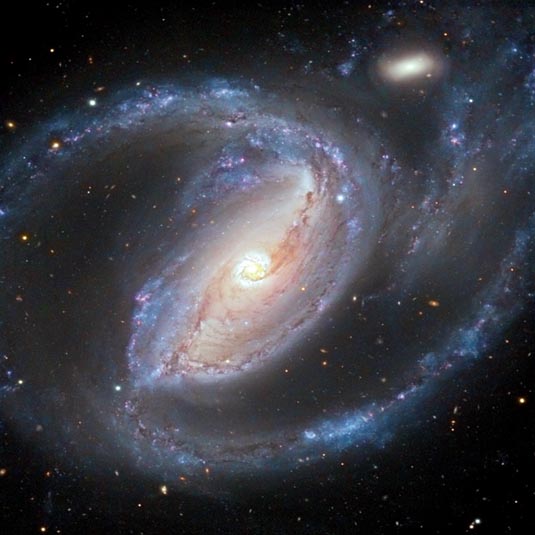
Description: Interacting Galaxies
Position: RA: 2h 46m 19.13s Dec: -30° 16' 30.93"
Constellation: Fornax
IDistance: 50 million light years
Field of view: 7.13 x 8.04 arcminutes
Orientation: North is 1.2° left of vertical
Image Credit: ESO/R. Gendler
Release Date: July 11, 2011
ABOUT THIS IMAGE:
Two galaxies, about 50 million light-years away, are locked in a galactic embrace - literally. The Seyfert galaxy NGC 1097, in the constellation of Fornax (The Furnace), is seen in this image taken with the VIMOS instrument on ESO's Very Large Telescope (VLT). A comparatively tiny elliptical companion galaxy, NGC 1097A, is also visible in the top left. There is evidence that NGC 1097 and NGC 1097A have been interacting in the recent past.
Although NGC 1097 seems to be wrapping its companion in its spiral arms, this is no gentle motherly giant. The larger galaxy also has four faint jets - too extended and faint to be seen in this image - that emerge from its center, forming an X-shaped pattern, and which are the longest visible-wavelength jets of any known galaxy. The jets are thought to be the remnants of a dwarf galaxy that was disrupted and cannibalized by the much larger NGC 1097 up to a few billion years ago.
These unusual jets are not the galaxy's only intriguing feature. As previously mentioned, NGC 1097 is a Seyfert galaxy, meaning that it contains a supermassive black hole in its center. However, the core of NGC 1097 is relatively faint, suggesting that the central black hole is not currently swallowing large quantities of gas and stars. Instead, the most striking feature of the galaxy's center is the ring of bright knots surrounding the nucleus. These knots are thought to be large bubbles of glowing hydrogen gas about 750-2500 light-years across, ionized by the intense ultraviolet light of young stars, and they indicate that the ring is a site of vigorous star formation
With this distinctive central star-forming ring, and the addition of numerous bluish clusters of hot, young stars dotted through its spiral arms, NGC 1097 makes a stunning visual object.
The
data were originally taken in 2004 with the VIMOS instrument on the VLT,
and additional color information from an image taken by amateur astronomer
Robert Gendler has been superimposed. The VLT data were taken through
three visible-light filters: R (at a wavelength of 652 nanometers, and
shown here in red), V (a wavelength of 540 nanometers, shown in green),
and B (456 nanometers, shown in blue). The image covers a region of approximately
7.7 x 6.6 arc-minutes on the sky
From Wikipedia:
NGC 1097 (also known as Caldwell 67) is a barred spiral galaxy about 45 million light-years away in the constellation Fornax. It was discovered by William Herschel on 9th October 1790. Three supernovae (SN 1992bd, SN 1999eu, and SN 2003B) have been observed in NGC 1097.
NGC 1097 is also a Seyfert galaxy. Deep photographs by Wolstencroft & Zealey (1975), Arp (1976), and Lorre (1978) revealed four narrow optical jets that appear to emanate from the nucleus. Arp interpreted these as manifestations of the (currently weak) active nucleus.
Subsequent analysis of the brightest jet's radio-to-X-ray spectral energy distribution by Carter, Allen & Malin (1984), Wehrle, Keel, & Jones (1997) and Higdon & Wallin (2003) were able to rule out synchrotron and thermal free-free emission. The optical jets are in fact composed of stars. The failure to detect atomic hydrogen gas in the jets (under the assumption that they were an example of tidal tails) using deep 21 cm HI imaging with the Very Large Array radio telescope and numerical simulations led to the current interpretation that the jets are actually the shattered remains of a cannibalized dwarf galaxy (Higdon & Wallin 2003).
Like most massive galaxies, NGC 1097 has a supermassive black hole at
its center. Around the central black hole is a ring of star-forming regions
with a network of gas and dust that spirals from the ring to the black
hole. NGC 1097 has two satellite galaxies. Dwarf elliptical galaxy NGC
1097A is the larger of the two. It is a peculiar elliptical galaxy that
orbits 42,000 light-years from the center of NGC 1097. Dwarf galaxy NGC
1097B, the outermost one, was discovered by its HI emission (5 x 10^6
solar masses; Higdon & Wallin 2003), and appears to be a typical dwarf
irregular. Little else is known about it.